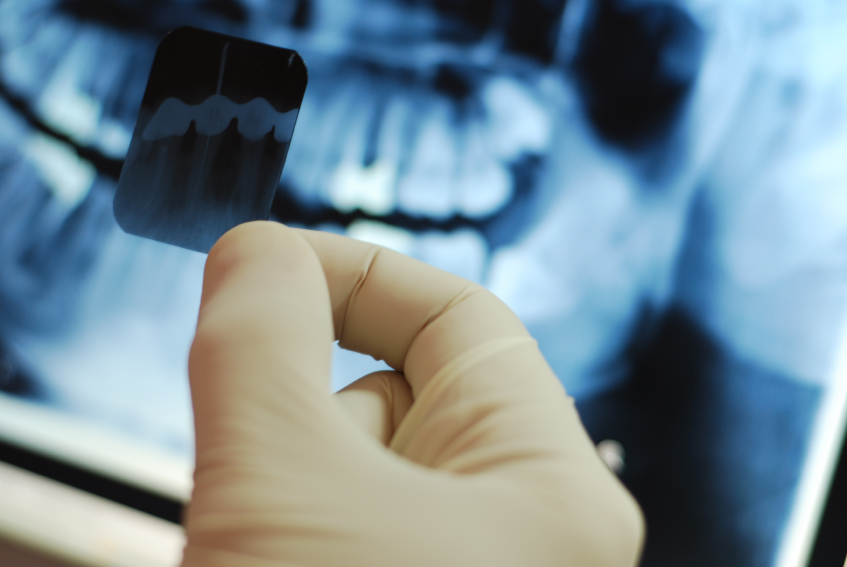Are We Getting Too Much Radiation From Dental X-Rays?

by Dr. Thomas P. Connelly
.
I remember when I was a little kid, and I went to the dentist for X-rays. It was a very uncomfortable procedure, with me laying back in a chair, a heavy weight placed on me (obviously to crush me), biting down on a metal torture device, while a cannon shot radiation into my body that would turn me into a mutant (and if the X-rays came out bad, well, the dentist would smile evilly as he reached for the needle and the drill …)
.
At least that’s how my eight-year-old eyes saw it.
.
Of course, now that I’m an NYC Cosmetic Dentist, I know differently. We aren’t evil (most of us aren’t, anyway), the drill is very necessary, the needle eliminates the pain and the radiation given is scant. Which is this week’s topic — I’d like to talk a bit about radiation and dental X-rays.
.
There is a perception that the radiation that you get from dental X-rays is “bad.” I’m here to tell you that is not so, and that I believe that the information your dentist gleams from x-rays is well worth the scant amounts of radiation.
.
Let’s begin with addressing two obvious questions people have — “If the radiation is not bad, then why the heavy lead blanket? And why does the dentist leave the room?”
.
The answers are “Why NOT?” and “Because they do it all day.” I’ll expand.
.
Yes, X-rays have concentrated radiation. Again, the amounts are very small (and they are getting smaller, which we’ll go over a little further down), but if there will be x-rays taken of your mouth, it makes perfect sense to shield your neck and upper torso — because why have radiation exposure to those areas when it’s not needed? And really, that’s all the shield is.
.
The dentist leaves the room because they do this all day long — yes, sitting for one X-ray session (as you are) isn’t bad. But the dentist might do 10 of these in a day. That’s ten times the exposure you get, and then they do it day after day after day. So that’s why they leave the room. OK, now that I answered those two main questions, allow me to present a few facts/findings regarding radiation and dental x-rays.
.
Dental X-rays are very targeted
Unlike conventional X-rays on other parts of the body (which usually take a picture of a large area), dental X-rays are very targeted to a small part of the body. In fact, it’s typically shot via a cone (like a laser), and very focused. This ultra-precise targeting (plus your lead apron) ensures that just a small part of the body receives the small dose of radiation.
.
The exposure is minimal compared to other types of X-rays, and even daily living
According to the American Dental Association (1), the radiation you receive is scant. Using a millisievert (mSv) scale to measure doses, you could expect 0.038 from Bitewing X-rays, and 0.150 from a full mouth X-ray. Of course, those numbers are practically meaningless unless you compare them to other types of X-rays:
*Lower Gastrointestinal Tract – 4.060
*Chest x-ray – .080
*Radiation from space in Denver Co. – 0.510 (per year)
*Avg. natural radiation in the US (per year) – 3.00
.
So essentially, you get about three and a half times the radiation from space (if you live in Denver) than you do from a full mouth X-ray.
.
Radiation also is present in just about everything from one degree or another — if you remember your high school science class, even a banana has radiation! Discover magazine printed a good article on this a few years ago (2). So really, your radiation exposure is just a matter of degree. That’s where the 3.00 mSv avg. natural radiation comes from.
.
With digital x-rays, Dental x-rays emit even less radiation
Digital X-rays have been around for awhile now, and are quite popular, although I will say that not all dentists use them, because the equipment is expensive. But the advantages are so profound (3) that I believe you should probably seek out a dentist who does. Amongst the benefits are: immediate viewing of the digital image, easy storage for comparison, the ability to enhance the image, better communication between dental practitioners (when you can e-mail an X-ray, it’s a huge time saver), and (ready for it?) LOWER radiation. In some cases, up to 80 percent lower. This is a pretty big deal.
.
As you can see, the radiation you get from dental X-rays is negligible (even without the just-mentioned digital x-rays). You receive more radiation by just “living” than you do by going to your dentist. But the benefits of dental X-rays are huge — in most cases, we cannot see dental issues without them. With X-rays, we can catch that cavity well before you feel it — without an X-ray, it could linger (painlessly, even), until the tooth becomes infected. Then, it’s generally either a root canal, or you lose the tooth. That’s a heavy price to pay — trust me, the X-ray is well worth it.
.
Until next time, keep smiling!
.
(1) http://www.ada.org/2760.aspx
(2) http://discovermagazine.com/2007/jun/life-is-rad
(3) http://jada.ada.org/content/135/10/1437.full
.




